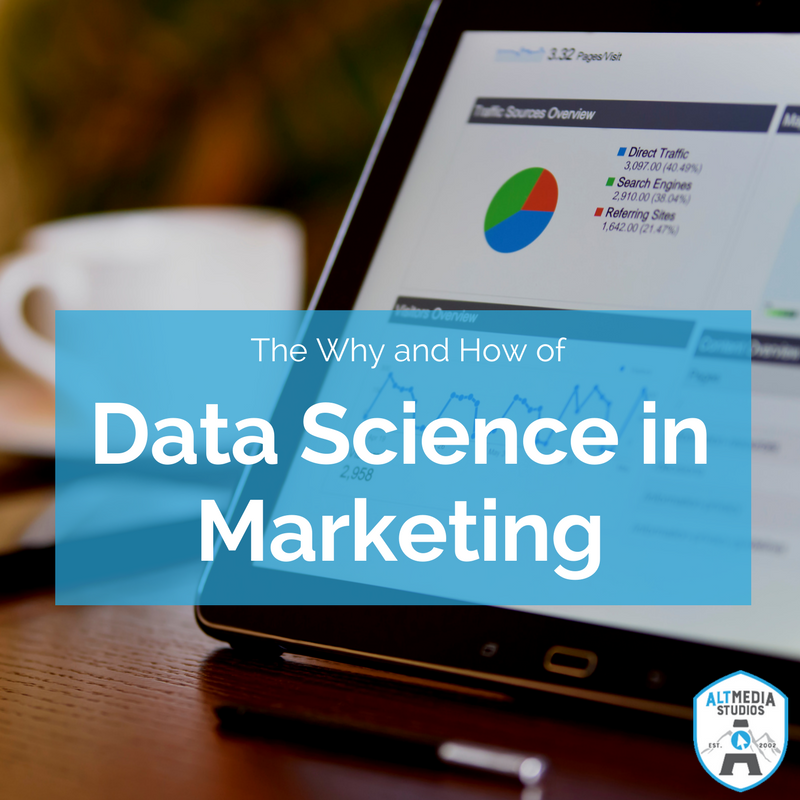Improving your digital presence is an adventure. Let us guide you through it.
Contact us using the form below and one of our team members will reach out as soon as possible.
(*) - Required field

What is data science and why is it important in your marketing strategy? More importantly, how can you use the data to your benefit? This blog explains.

How
many
data
scientists
do
you
have
on
your
payroll?
Some
large
corporations
have
dozens.
Some
have
none.
Even
if
you
don’t
have
someone
like
that
on
your
staff,
you
need
to
make
certain
you
have
someone
who
is
thinking
like
a
data
scientist.
In
fact,
you
really
want
your
marketing
team
to
think
this
way.
Thinking
like
a
data
scientist
allows
your
team
to
move
from
guessing
about
information
to
knowing
it.
But
how
can
you
do
that?
We
have
a
few
tips
that
will
help
your
marketing
department
think
like
data
scientists.
When
you
make
statements
that
start
with
“I
think…”
you’re
showing
that
you
don’t
really
know.
You’re
basing
conclusions
on
guesswork
and
estimations
that
may
not
be
correct
at
all.
When
you
start
with
“I
know”
and
have
hard,
unbiased
data
to
back
up
your
statements,
you’ll
make
much
more
of
an
impression.
You’ll
be
treated
more
seriously.
Data
science
can
be
defined
as
harnessing
your
data
to
help
your
company
make
better
business
decisions.
These
decisions
can
be
made
at
any
level
and
by
anyone
from
the
CEO
down
to
an
assistant,
but
when
they’re
used
in
marketing,
you’re
able
to
make
better
decisions
and
predictions
for
your
campaigns.
This
allows
you
to
make
your
campaigns
more
targeted
and
to
create
better
content.
If
you
go
to
your
CEO
with
a
marketing
plan
based
on
data,
it’s
much
more
likely
to
be
approved.
It’s
also
more
likely
to
succeed,
which
makes
you
and
your
team
look
better.
Being
able
to
make
better
predictions
affects
everything
from
which
brands
are
going
to
do
well
to
what
stocks
increase.
In
many
corporations,
you
as
the
head
of
marketing
are
expected
to
be
able
to
make
very
accurate
predictions
about
your
customer
base.
It’s
not
always
easy,
but
it’s
what
you’ve
been
charged
with.
That’s
why
thinking
like
a
data
scientist
is
so
important.
You
can’t
simply
think
like
someone
building
a
marketing
campaign
using
what
you
think
is
true.
You
have
to
know
it
and
have
facts
behind
you.
While the above definition of data scientist sheds some light on what they do, the question is who are they? Data scientists are usually found in areas of business, mathematics, and technology. They analyze the data they collect and organize in three different ways:
Marketers
are
most
often
concerned
with
descriptive
data.
They
use
Google
Analytics
and
other
tools
to
see
how
customers
and
potential
customers
interacted
with
their
marketing
plans.
This
data
is
historical
in
that
it
looks
only
at
past
interactions
by
gathering
information
on
click-through
rates,
cost
per
click,
and
other
data.
It
gives
you
an
idea
of
where
you’ve
been
and
what
you’ve
done.
Predictive
analytics,
on
the
other
hand,
is
a
way
of
showing
you
where
you’re
going.
It
takes
this
historical
data
and
combines
it
with
real-time
information
to
predict
what
customers
might
do.
It
can
generate
Marketing-Qualified
Leads
(MQLs)
that
you
can
pass
over
to
the
sales
department.
Since
predictive
analytics
are
updated
with
real-time
information,
you
can
adjust
your
plan
midway
through
if
new
data
comes
in.
While
most
marketers
deal
with
descriptive
analytics,
fewer
work
with
predictive
analytics.
Fewer
still
work
with
what’s
called
prescriptive
analytics.
This
type
of
data
usage
goes
beyond
predictive
analytics
so
that
you
can
determine
what’s
going
to
occur
and,
more
importantly,
what
methods
you
need
to
employ
to
take
advantage
of
what
you
expect
will
happen.
You
can
predict
what’s
going
to
occur
and
the
best
way
to
deal
with
that
outcome.
One
example
of
prescriptive
analytics
can
be
found
in
Watson,
the
AI
created
by
IBM.
When
Watson
asked
to
create
ads
on
social
media
and
track
their
performance.
Several
weeks
later,
Watson
predicted
that
one
image
wasn’t
providing
the
click-through
rate
needed
and
recommended
replacing
it.
When you start to think like a data scientist, you’ll be able to better think out your content, refine it, and measure the outcomes through predictive modeling. This modeling lets you use various techniques and models that you couldn’t make use of otherwise.
When you think like a data scientist, you can create predictive models that can steer your content in a more effective direction. These models will be able to predict a number of things:
Testing
is
vital
to
refining
your
content
into
the
best
it
can
be.
Like
any
scientist,
you’ll
begin
with
a
hypothesis,
or
content
that
you
believe
your
audience
will
like.
Then
you
test
that
content
through
serial
testing,
A/B
testing,
or
other
types
of
tests.
At
this
point,
gathering
data
is
actually
more
important
than
your
content
reaching
your
target
audience.
Once
you’ve
gathered
data
and
analyzed
it,
you
now
have
hard
facts.
You
can
say
with
authority
that
content
A
did
not
perform
as
well
as
content
B.
You
can
then
create
content
C
from
this
information
and
test
it
against
A.
The
cycle
of
testing,
refining,
and
testing
again
continues.
Data
scientists
continue
this
cycle
for
as
long
as
they
need.
Sometimes
completely
new
content
is
thrown
in
to
see
if
going
in
a
very
different
direction
would
produce
better
results.
Being
creative
is
just
as
important
as
narrowing
down
the
data
and
refining
content.
To
measure
your
content’s
or
marketing
campaign’s
results,
you
need
a
model
that
takes
into
account
all
factors.
This
model
is
usually
a
type
of
algorithmic
multi-touch
content-attribution
model.
That’s
a
mouthful
to
say,
but
it’s
a
fairly
easy
concept
to
understand.
This
model
looks
at
what
your
customer
viewed
and
which
content
(or
combination
thereof)
was
effective.
This
provides
hard
numbers
that
CEOs
and
others
love
to
see.
With
this
information,
you
can
confidently
present
data
at
your
next
board
meeting
that
shows
how
you’re
progressing
against
your
budget.
You
can
list
off
your
marketing-qualified
leads,
sales-qualified
leads,
customers,
and
more.
All
of
this
can
be
done
easily
and
without
creating
anything
really
new
or
different.
In
fact,
most
of
it
is
thanks
to
JavaScript.
This
programming
code
is
used
in
multiple
social
media
sites
and
can
be
harnessed
to
let
you
track
all
the
data
you
need.
You
may
need
to
consult
with
an
actual
data
scientist
here
in
order
to
build
a
model
that
perfectly
fits
all
of
your
needs.
However,
there
are
some
things
you
can
do
to
get
started:
Business
involves
numbers.
There’s
no
way
around
that.
To
really
impress
the
leadership
at
your
business
and
make
them
see
you
as
someone
to
take
note
of,
you
need
to
be
able
to
talk
numbers.
Specifically,
you
need
to
be
able
to
talk
about
your
return
on
investment
or
ROI.
This
is
often
the
bottom
line.
It’s
hard
for
someone
in
content
marketing
to
figure
out
how
to
talk
this
language,
but
it
can
be
done.
First,
you
need
to
forget
ROI
and
look
specifically
at
ROMI,
or
your
Return
on
Marketing
Investment.
ROI
is
usually
only
used
when
looking
at
something
that
has
been
sold.
Marketing
doesn’t
really
deal
with
that.
Instead,
you
can
look
at
the
cost
and
the
profit
that
relates
directly
to
marketing
or
a
marketing
campaign.
Consider
ROMI
to
be
the
incremental
net
income
divided
by
the
cost
of
your
marketing
campaign
times
100
percent.
Then
you
need
to
talk
about
CLTV
or
the
Customer
Lifetime
Value.
This
number
is
an
idea
of
how
much
one
customer
will
bring
in
over
their
entire
lifetime
with
the
company.
If
you’re
investing
more
to
bring
in
a
customer
than
what
the
average
CLTV
is,
you’re
likely
losing
money.
How
do
you
calculate
CLTV?
Take
the
average
amount
of
income
per
customer,
multiply
it
by
their
lifetime,
and
then
multiply
that
by
the
gross
margin.
You
can
determine
your
gross
margin
by
figuring
the
ratio
of
total
income
to
the
total
cost
of
goods
sold
minus
the
costs
of
services.
That’s
a
lot
of
math,
and
as
a
content
marketer,
it
might
be
more
than
you
want
to
deal
with.
There’s
no
shame
in
bringing
in
a
data
scientist
to
handle
all
of
this.
That’s
especially
true
if
your
marketing
team
is
fairly
small
and
you’re
needed
to
keep
on
top
of
the
latest
campaign.
You
might
not
have
time
to
do
this
work.
Measuring
your
content’s
performance
also
requires
a
model.
In
fact,
another
multi-touch
algorithmic
attribution
model
is
needed.
This
model
can
take
information
such
as
the
UTM
data
you
add
to
website
URLs.
This
data
tells
you
what
website
the
user
came
from.
For
example,
you
can
use
this
to
see
who
is
coming
to
your
website
from
your
Facebook
profiles.
That’s
just
one
of
the
most
basic
ways
to
use
UTM
codes.
Once
you
have
this
data,
you
can
use
the
model
to
determine
how
well
that
part
of
your
campaign
is
performing.
Always
keep
one
thing
in
mind
when
you’re
determining
how
to
measure
your
campaign’s
performance:
what
will
you
do
with
the
information
you
get?
That’s
necessary
to
design
the
model
correctly
and
to
determine
what
data
you
need
to
collect.
The easiest and best thing to do to gather all of this data, create the needed models, and draw the right conclusions is to hire a data scientist. This way, you have a creative person on hand to build your models. If that’s not an option, you can look at SaaS platforms that make use of predictive modeling. You’ll have to spend time learning how to use these models, but they can be a more affordable option.
Overall, if you’re a content marketing expert, you have to know how to examine data and draw conclusions from it. You don’t have to be a data scientist, but you need to know how to think like one.

Where should you direct your marketing efforts for the biggest payoff? How can you increase site traffic? These questions and more can be answered by using Google Analytics. Here’s why we love it and recommend it to our customers.

Why does a privacy policy have to be on your radar?

Optimization of images holds a critical role in enhancing the performance of your website. By tailoring your images to be web-friendly, you not only ensure swift loading times but also deliver an improved user experience.